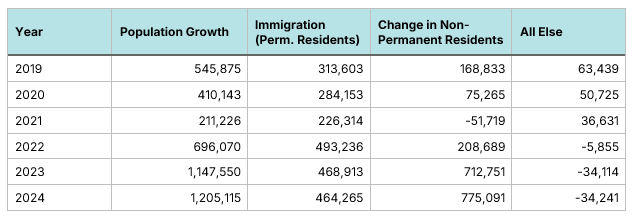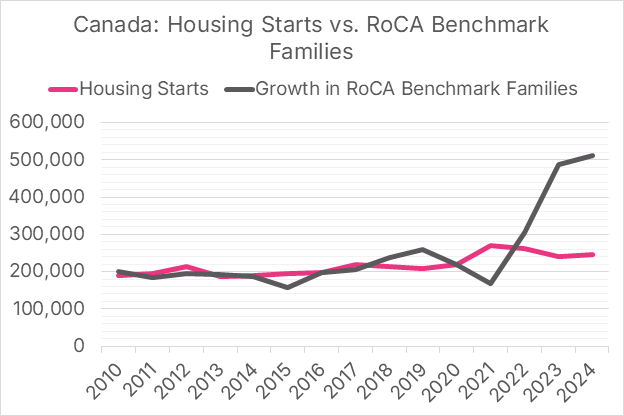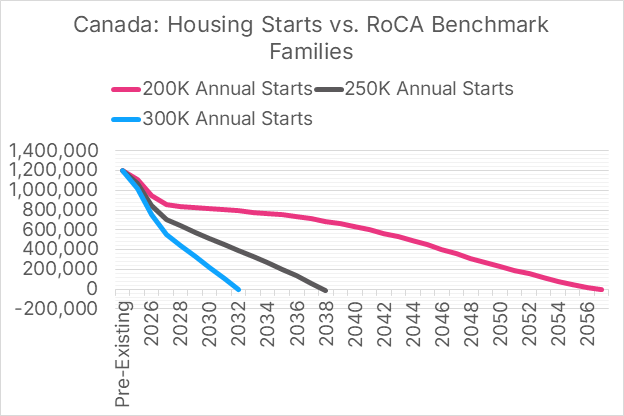Canada Can Close the Housing Supply Gap by 2032
Success is possible, but it will take some substantial reforms
Highlights
Canada’s housing shortage was estimated at 690,000 units in 2021, with 470,000 units of that shortage occurring in Ontario.
The rapid population growth of the last two years has caused the housing shortage to increase by over 510,000 units, bringing the total to 1.2 million.
Recent federal reforms will substantially reduce demographic-based housing demand to an average of 120,000 units a year over the next three years, then 175,000 units a year for the next two decades.
This slower population growth will allow Canada to reduce the housing shortage substantially. If housing starts remain at the the current 250,000 units per year, the housing gap can be completely closed by 2038. If starts increase to an average of 300,000 per year, the gap can be eliminated by 2032.
Although the supply gap may appear insurmountable, it can be closed through a combination of robust supply reforms and sustainable population growth policies.
One of the most frequent questions we’re asked at the Missing Middle is, “How long will it take to fix the housing crisis?” Thanks to population projections released by Statistics Canada earlier this month, we can begin to answer this question.
In an earlier CHMP piece, we used the RoCA Benchmark method and Census 2021 to estimate that Canada had a housing shortage of 690,000 units, with 490,000 of those occurring in Ontario.
Figure 1. Canadian Housing Shortages by Province as of 2021
This analysis, unfortunately, dramatically understates the extent of Canada’s housing shortage, as the Census was conducted in May 2021, when Canada’s population growth had slowed to a crawl thanks to COVID-era border measures. Since then, Canada’s population has grown substantially due to the international student boom.
Figure 2. Components of Population Growth, Canada, Previous 6 Years
This population surge caused housing starts to become disconnected from the growth of the number of RoCA Benchmark families. In 2023 and 2024, approximately 1 million additional RoCA Benchmark families were added to Canada, but only 490,000 housing starts were made, creating a gap of 510,000 homes.
Figure 3. Housing Starts vs. Growth in RoCA Benchmark Families in Canada, 2010-24
Adding the Census 2021 housing shortfall (690,000 units) and the shortfall from the past two years (510,000 units) creates a shortfall of roughly 1.2 million units.
Canada’s 30,000-foot housing objective should be to not only build enough homes to keep up with future population aging and population growth but also fill the existing shortage of 1.2 million homes. Of course, this is an exceptionally blunt objective, as it does not consider the type and size of the home, whether it is ownership or rental housing, where it is located, and at what price, but it at least indicates the magnitude of the need.
Closing this gap may be easier than it first appears, thanks to recent federal government changes to immigration and international student programs. On January 21st, Statistics Canada released updated population projections, which project that Canada will experience little population growth over the next three years (with one of those years featuring an absolute decline in population), followed by growth of approximately 330,000 persons per year, similar to growth levels experienced in the mid-2010s.
Figure 4. Components of Population Growth, Canada, Next 6 Years, Statistics Canada Projections
Because Statistics Canada provides population projections by age, we can apply the RoCA Benchmark method to convert population projections into family formations. Interestingly, despite the projected population decline in 2026, the RoCA Benchmark finds that the number of families will slightly increase due to a high number of persons in their mid-20s entering their family formation years.
Figure 5. Increase in RoCA Benchmark Families by Year, Number of Families
If the population projections prove accurate, Canada will add approximately 250,000 families total over the next three years, less than 100,000 per year. After that, Canada will add 185,000 households in 2028, with this figure slowly declining to 152,000 by 2048 due to the aging of the Baby Boomers. After 2048, the number of net new households will rise, crossing the 200,000 threshold by Canada’s bicentennial in 2067. Canada averaged 200,000 new RoCA households each year from 2010-19, so reaching 200,000 would put the country in line with historical norms.
Given that Canada has averaged 235,000 housing starts a year over the last eight years, it should be possible to close the housing supply gap if the number of families is growing by less than 200,000 a year. If Canada can average 250,000 housing starts a year, right around recent averages, the housing supply gap will be fully closed by 2038. Ramping up building to 300,000 units a year can allow us to eliminate the gap by 2032, whereas a more modest 200,000 starts a year would see the shortage persist until 2057.
Figure 6. Increase in RoCA Benchmark Families by Year, Number of Families
Our projected timelines are a highly simplified analysis that treats a “unit as a unit as a unit,” and there is no guarantee that Statistics Canada’s projections will prove accurate. However, it should at least give some comfort that the country can address the supply gap in a reasonable time.
Download a PDF version of this article here:








